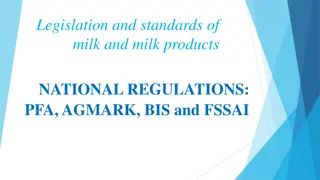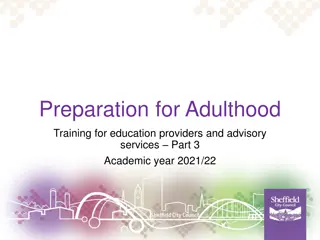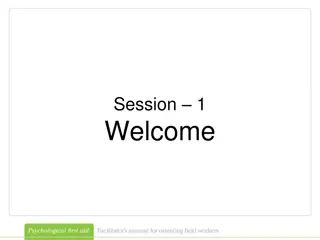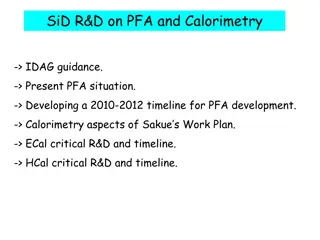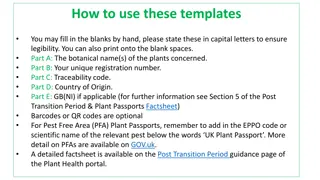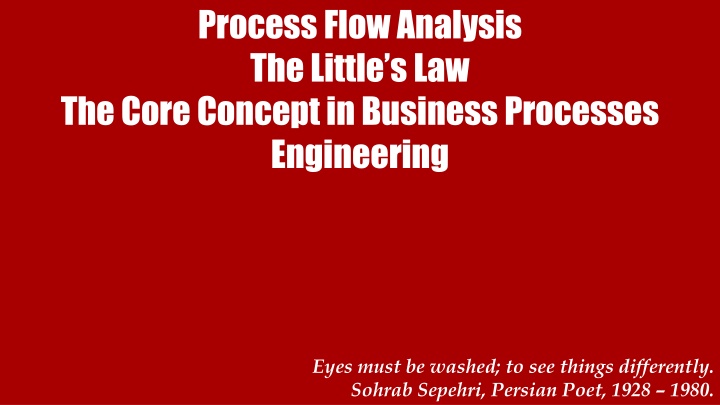
Process Flow Analysis and The Little's Law in Business Processes
Explore the core concept of Process Flow Analysis and The Little's Law in business processes, as demonstrated through examples like a coffee shop scenario. Learn about throughput, inventory, and flow time in stable systems. Dive into the fundamentals of input and output dynamics for effective operations management.
Download Presentation

Please find below an Image/Link to download the presentation.
The content on the website is provided AS IS for your information and personal use only. It may not be sold, licensed, or shared on other websites without obtaining consent from the author. If you encounter any issues during the download, it is possible that the publisher has removed the file from their server.
You are allowed to download the files provided on this website for personal or commercial use, subject to the condition that they are used lawfully. All files are the property of their respective owners.
The content on the website is provided AS IS for your information and personal use only. It may not be sold, licensed, or shared on other websites without obtaining consent from the author.
E N D
Presentation Transcript
Process Flow Analysis The Little s Law The Core Concept in Business Processes Engineering Eyes must be washed; to see things differently. Sohrab Sepehri, Persian Poet, 1928 1980.
Recorded Lecture Process Flow Analysis, Key Problem 1, A. Asef-Vaziri, Systems & Operations Management. 2
Hour Zero 1 1 20 10 10 100 10 9 9 9 Process Flow Analysis, Key Problem 1, A. Asef-Vaziri, Systems & Operations Management. 3
K1 . The Coffee Shop A manager of a local coffee shop near the Reseda and Plummer intersection realized that during busy hours, the entrance door opens, on average, once per minute, and a customer enters. In a stable system, if one customer enters per minute, one customer should leave per minute. In the short run, we may have variations, but over a long period, output cannot be less than input. Output should be equal to input. It is possible that in 5 minutes, 4 customers come in, and 7 customers go out. However, over a long period (even a day), the output cannot exceed input, because how can that difference be generated? On average, in 5 minutes, 5 customers enter and 5 customers leave. Similarly, the output cannot be less than input, because, over a long period, there will be no room in the coffee shop (or even in a large stadium). It is possible that in 5 minutes, 9 customers come in and 6 customers go out. However, over a full day, input cannot exceed output. Input should be equal to output. Process Flow Analysis, Key Problem 1, A. Asef-Vaziri, Systems & Operations Management. 4
K1 . The Coffee Shop In stable systems, flow units come in as input, leave the system as output, and input per unit of time is equal to output per unit of time. If, on average, one customer comes in per minute, then on average, one customer should leave per minute. a) What is the throughput (R) of the coffee shop? Every minute, 1 customer enters and 1 customer leaves. R= 1 per minute. Throughput is the average flow rate in a stable system (where the average input is equal to average output over an extended period). Throughput is expressed as a number with a time unit attached to it (e.g. per minute, per hour, per day, per month, etc.). Inventory (I) is the number of flow units in the system (e.g. customers in a coffee shop, headcount of students at CSUN, cars in a dealership, etc.). Inventory is a number with no time unit attached to it. Process Flow Analysis, Key Problem 1, A. Asef-Vaziri, Systems & Operations Management. 5
K1 . The Coffee Shop On average, there are 5 customers in the store (system), 4 are waiting in line (buffer) to order, and one is with the server. b) What is the inventory (I) in the coffee shop? On average, there are 5 customers in the coffee shop. Inventory is 5. I = 5 flow units. R = 1 flow unit per minute c) How long, on average, is a customer in your coffee shop? Flow Time is indeed inventory expressed in units of time. Process Flow Analysis, Key Problem 1, A. Asef-Vaziri, Systems & Operations Management. 6
K1 . The Coffee Shop Flow Time (T) is the time it takes an input to become an output. It is the time a flow unit spends within a system. Before a customer steps into the system, there are 5 other customers in the system. At the instant she steps into the line for service, one fully served customer leaves the system. That is, there are always 5 people in the system. Our incoming customer at the beginning has 4 people in front of them, then 3 in front and 1 behind, then 2 in front and 2 behind, then 1 in front and 3 behind, then no one in front and 4 behind her. At the instance when she steps out of the system, just in the fraction of second stepping out, she looks over her shoulder. How many people are behind her? 5 people. At what rate did they come in? Process Flow Analysis, Key Problem 1, A. Asef-Vaziri, Systems & Operations Management. 7
K1 . The Coffee Shop 1 per minute. How long does it take 5 people to come in if they arrive at the rate of 1 per minute? 1 minute How many minutes (T) T = (1 5)/1 T = 5 minutes. We could have also said: How many customers are in the system? 5 customers. At what rate are they served? 1 per minute. How long does it take to serve 5 people at the rate of 1 per minute? T= 5/1 = 5 minutes. 1 customer 5 customers Process Flow Analysis, Key Problem 1, A. Asef-Vaziri, Systems & Operations Management. 8
K1 . The Coffee Shop On average, a customer spends 5 minutes in the coffee shop; flow time (T) is 5 minutes. Each customer enters the coffee shop, spends 5 minutes on average and then leaves. In the above computation, the flow time (T) is defined in minutes, because R was in minutes. R carries a time unit with it, i.e., 1/minute., 1(60) = 60/hour, and, if a day is 8 hours, it can also be expressed as (60) (8) = 480/day. However, remember: inventory (I), does not carry a time unit, it is always a number. Now, let us generalize: 1 time unit R flow units How many time units (T) I flow units T= I*1/R T = I/R RT= I. Process Flow Analysis, Key Problem 1, A. Asef-Vaziri, Systems & Operations Management. 9
K1 . The Coffee Shop The Little s Law is expressed as Throughput x Flow Time = Inventory. R T = I or T = I/R or R = I/T A Fundamental Insight.Note, that the Little s Law, T=I/R, is nothing more than a unit conversion, converting numbers into time. It turned 5 units of inventory into 5 minutes of inventory. Suppose we have 100 units of item A, and 1,000 units of item B. What item do we have more of? In the count dimension, item B has a higher inventory. Suppose we use 4 units of item A per day (RA= 4/day), and 200 units of item B per day (RB=200/day). In the time dimension, we have (T=100/4), 25 days inventory of item A, and (T=1,000/200) 5 days inventory of item B. On the time dimension, the inventory of item A is larger than the inventory of item B. It takes more time to consume the inventory of item A, compared to that of consuming item B. Process Flow Analysis, Key Problem 1, A. Asef-Vaziri, Systems & Operations Management. 10
K1 . The Coffee Shop In addition to measuring inventory in count and time dimensions, we can measure it on the third dimension of value. How much money is invested in the inventory of each item? This is useful in financial planning, cost analysis, and warehouse operations. There is even a fourth dimension. How much space (in a warehouse)? For items taking a large portion of a warehouse, we may conduct a more careful warehouse design. For a large number of items which may take a small portion of warehouse, we may have a rough design. Units Space Value Inventory Time Process Flow Analysis, Key Problem 1, A. Asef-Vaziri, Systems & Operations Management. 11
K1 . The Coffee Shop Now suppose there are two waiting lines. Suppose R is still 1 per minute and still on average there are 5 customers in the first line to pay for their order and get their non- exotic orders. In addition, suppose there are 4 customers in the exotic order (latte, cappuccino, etc.) waiting line. 40% of the customers place exotic orders. What is the flow time of a person who orders latte, cappuccino, etc. 1/min Such a customer spends 5 minutes in the first line. Throughput of the second line is R= 0.4(1) = 0.4 customers per minute. Inventory of the second line is 4. RT=I 0.4T=4 T=10 Simple order T =5, Exotic order T= 5+10 = 15 Process Flow Analysis, Key Problem 1, A. Asef-Vaziri, Systems & Operations Management. 12
K1 . The Coffee Shop What is the flow time of a customer? S/he is neither a customer who puts in a simple order nor one with exotic order, but s/he is both. Procedure 1- Not good. 60% simple order: T = 5, 40% exotic order: T=5+10= 15 A customer: T= 0.6(5) + 0.4(15) = 9 minutes Procedure 2- Not bad. Everyone goes through the first process and spends 5 minutes. 60% spend no additional time, 40% spend 10 additional minutes. 0.6(0) + 0.4(10) = 4 4+5 =9. Procedure 3- Good. Throughput of the system is 1 per minute. There are 9 people in the system (5 at the register and 4 in the second line). RT= I 1T=9 T=9 Throughput in this system was 1 per minute or 60 per hour or 720 per day (assuming 12 hours per day). But inventory in the system is always 9. Process Flow Analysis, Key Problem 1, A. Asef-Vaziri, Systems & Operations Management. 13
K1b . The Coffee Shop You enter a Starbucks coffee shop. The door opens every 20 seconds. Once for a customer to come in, once for a customer to leave. On average there are 6 customers in the line. What is the throughput of this system. Every 40 seconds, one customer enters and one customer leaves. Customer Time (s) 1 40 x 1 X = (1 1)/40 1/40 per second Process Flow Analysis, Key Problem 1, A. Asef-Vaziri, Systems & Operations Management. 14
K1b. The Coffee Shop R= 1/40 per second. R= How many per minute? R= (1/40)60 = 1.5 per minute. R= How many per hour? R= (1.5)60 = 90 per hour. If there are 4 busy-hours of this type, R= How many per 4-busy-hour-day? R= 90(4) = 360 If a month is twenty 4-hour-busy days, R= How many per month? R = 20(360) = 7,200 per month R = 1.5 per minute. There are 6 customers in the line, how long does it take you to get your coffee and leave. In all these situations there are always, on average, 6 customers in the waiting line. Process Flow Analysis, Key Problem 1, A. Asef-Vaziri, Systems & Operations Management. 15
K1b. The Coffee Shop 1.5/min 1.5/min I = 6 RT=I 1.5T=6 T= 4 minutes Now suppose there are two waiting lines. R is still 1.5 per minute, and still, on average, there are 6 customers in the first line to pay for their order and get their non- exotic orders. In addition, there are 3 customers in the exotic order (latte, cappuccino, etc.) waiting line. 1/3 = 33.33333333333333333333333333333333333333% of the customers place exotic orders. What is the flow time of a person who orders latte, cappuccino, etc.? 1.5/min 1.5/min 2/3 Process Flow Analysis, Key Problem 1, A. Asef-Vaziri, Systems & Operations Management. 16
K1b. The Coffee Shop Such a customer spends 4 minutes in the first line. I= 6, R=1.5/min T=6/1.5= 4 ? 4 minutes since R is in minutes. Throughput of the second line is R= (1/3)(1.5) = 0.5 customers per minute. Inventory of the second line is 3. RT=I 0.5T=3 T=6 Simple order T =4. Exotic order T= 4+6 = 10 What is the flow time of a customer? S/he is neither a customer who puts a simple order nor one with exotic order, but s/he is both. Procedure 1- Not good. 2/3 simple order: T = 4 1/3 exotic order: T=10 A customer: T= (2/3)4 + (1/3)10 = 6 minutes Process Flow Analysis, Key Problem 1, A. Asef-Vaziri, Systems & Operations Management. 17
K1b. The Coffee Shop Procedure 2- Not bad. Everyone goes through the first process and spends 4 minutes. 2/3 spend no additional time, 1/3 spend 6 additional minutes. 0(2/3) + 6(1/3) = 2 4+2 = 6 Procedure 3- Good. Throughput of the system is 1.5 per minute. There are 9 people in the system (6 at the register and 3 in the second line). RT= I 1.5T=9 T=6 Process Flow Analysis, Key Problem 1, A. Asef-Vaziri, Systems & Operations Management. 18

